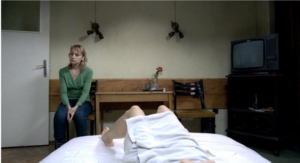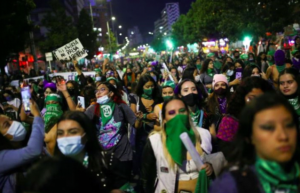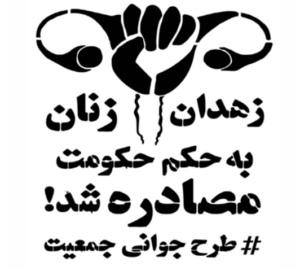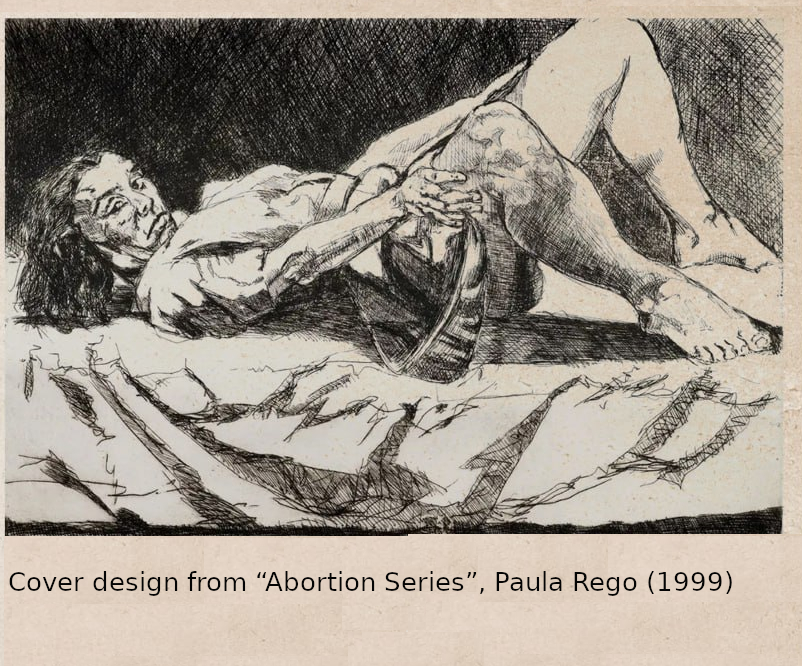This is an article by Hadil Core, a secret women’s committee inside Iran.
Regardless of your gender identity, if you have a body that is capable of pregnancy, you have most likely thought about the potentiality of getting pregnant and possible actions you must take afterwards.
Most women’s (and a portion of queer individuals’) lives are interwoven with the issue of pregnancy and how to control it. The degree of access to control over the body or lack of it affects not just sexual aspects but all aspects of individuals’ lives. Thus, considering discussions regarding control and voluntary termination of pregnancy merely as “women” and “cultural” issues that are considered secondary compared to the political-economic situation of society means exactly ignoring the level of impacts of these rights, specifically on the lives of working-class women and the future of the class struggle.
With the availability of education related to birth control and its tools and methods, as well as safe and free abortion services, women will have more options and choices in education, work, and freely forming a family. So, the birth of unwanted children will not impose such options on women. It is not far from the expectation that the children who are born in such conditions will have a more favorable situation both psychologically and in terms of livelihood. On the contrary, one can imagine that unwanted children, especially in a society that does not have the capacity to socialize the so-called women’s work, including childbearing, and its social services body is getting thinner day by day in the process of privatization, how much pressure and desperation will they be exposed to.
At the beginning of 2021, in Iran, a scheme titled “Population Growth and Family Support Plan” was approved to expand its dominance over the lives of millions of people more and more intensely than before. Prohibition and various restrictions related to contraceptive methods and the distribution of related materials had intensified since a decade ago, but this plan was an ambitious and unprecedented leap in this direction. According to this plan, the sale of contraceptive pills in pharmacies without a doctor’s prescription is prohibited, and doctors’ prescriptions are subject to the instructions of the relevant headquarters. Punishment for activities related to the voluntary termination of pregnancy and those involved in the sale and distribution of drugs and their devices have also been intensified, and any violation of the provisions of the plan has been criminalized. This detailed and ambitious scheme required the cooperation of countless executive bodies as well as a huge budget to implement the relevant mechanisms, although, after two years, it has become clear that the budgets allocated for the encouragement of childbearing, which includes promises such as giving land and housing, paying the loans, and having priority in receiving the car for the eligible have not been provided.
 4 Months, 3 Weeks and 2 Days, a film by Cristian Mungiu (2007)
4 Months, 3 Weeks and 2 Days, a film by Cristian Mungiu (2007)
The female body as a battlefield
Although much of the struggle for women around the world to regain control over their bodies, including the right to abortion, has been about obtaining legal rights and protections, it is clear that the main way forward is not through changing laws, but through fundamental political transformations. For example, in America, the right to voluntary abortion, which was approved by the Supreme Court of the USA fifty years ago, is disappearing, and the judges are also cancelling and limiting these rights. In such a context, women living in America have realized in practice that although every legal achievement and every degree of freedom of action should be honored, it is not possible to maintain these laws and to believe in the real companionship of politicians who use these rights in electoral competitions to shape their supporters. In fact, those politicians are not pro-life, rather they are in favor of electoral victories.
The right to voluntary abortion in the USA was included in the law during the height of social struggles in this country, including the anti-Vietnam War protests and the civil rights movement, to control the social force. In fact, this action was taken in order to prevent the struggle around this right from becoming an all-encompassing movement and to prevent feminist activists from seeing the achievement of such a right as a direct consequence of their victory in political struggles.

Nadine Faraj, Yo Aborte (2016)
Rights are to be taken
With a brief look at the countries where the women’s movement has been active and influential on a wide scale, it can be claimed that the organized will of women has always led to changing laws and improving their status in the legal field.
For example, in Latin America, which has a long tradition of struggle, except for exceptional cases such as Cuba (where the ruling Communist Party in 1965 included the full and free right to voluntary abortion in the constitution), it has been the insistence of women over the years that have finally brought the recognition of this right to women.
Women’s struggles in Argentina and their impact on other countries in the region can be an example of this claim. The struggle of women to achieve this right in connection with other movements such as the Mothers of the Plaza de Mayo (Complainant Mothers) and the “Even one person is too much” movement (movement to combat violence against women) finally gave results in 2020 and led to the approval of the related bill in the Senate.
Following this victory and its direct impact on the countries of the region, nearly two years after the change of the law in Argentina, Mexico and Colombia also joined the list of countries that recognize this right.
But this is not the end of the story. Experience has shown that women* have always been the victims of political games from above and the coming to power of religious/extreme right-wing currents, and gradually (for example, in Poland or in the United States progressively state by state) they lose the rights granted by the governments.
The right to the body and to make decisions for it (including the decision to have children or the voluntary abortion) is a part of the fundamental rights of anyone who has the possibility of becoming pregnant, which means that it is not negotiable or a case for referendum, and the government, political power or even the will of the absolute majority of society should not be able to violate it.
Therefore, to ensure the perpetuation of these fundamental rights and the enjoyment of all people, something more than the desire to change laws and legal demands is necessary because there is always the possibility that the granted rights could be taken back. We will return to this necessity.

“Neither death nor prison”, demonstration on the International Safe Abortion Day, Colombia, September 2021
A sword drawn by the name of “Population Growth and Family Support Plan”
Despite the common claim that the goal of plans like the Population Growth and Family Support Plan is demographic concerns and the well-being of future generations, as well as humanitarian concerns that mourn the souls of aborted fetuses and their pain and suffering, the intensification of attacks on birth control rights are reactions to critical situations, rather than being future-oriented and humanistic plans or programs. In America, one of the high points of these attacks coincided with the economic crisis of 2008, that is, when the ruling class found itself incapable of presenting a horizon for the future.
In Iran, where the current livelihood crisis and the cost of living have critically endangered the lives of today’s children, Khamenei talks about the gap of several million between the current population and his own ideal one. Similarly, recently after the retreat of one of the most turbulent social storms with the main slogan of “Women, Life, Freedom”, it is now that we are hearing the news on the creation of patrols to find “abortion criminals” as well as the initial registration of pregnancies for police follow-up.
In fact, one of the goals of such plans, apart from the expansionist demands aimed at increasing the population of Iranian Shiites, is to deprive women of their authority over their bodies (by depriving them of pregnancy prevention and abortion services) and imposing unwanted pregnancies on women in order to control their social and political presence. However, we should not and cannot ignore the ambitions of the Iranian state to increase the population, as a tool for expansion in the region, and of course, more importantly, as a cheap labor force, which is necessary for the accumulation of capital. However, in the final analysis, the human population in different historical periods has not been determined by people’s mental desires, but rather by historical evolution, so, what will be used to adjust the population in practice will be the production bases.
Advancing such goals, specifically by attacking women’s rights, privileges, and life, has another function, and that is creating a gap among the working class and hitting the possibility of this force to unite for class interests. What is mentioned under the title of “promoting the gender role of women, family, and Islamic lifestyle” in the basic and primary goals of such a plan, hand in hand with traditional prejudices and the principle of ‘honorism’ (honor crimes), has turned the oppression of women into a sublime value, and has set for men the important duty of protecting women. In this way, the captivity of a part of the working class by another part of it persists.
Regardless of the overt and covert intentions and goals of such a plan in the long run, its advancement will have tremendous effects on the lives of thousands of women, including child wives and child mothers. Promises of granting financial facilities and marriage loans without determining the minimum age, despite the fact that they have not and will not be fulfilled in practice due to the economic crisis, prepare the ground for the increase of child marriage more than before. The criminalization of contraceptive methods will also lead to the worsening of children’s pregnancy without the possibility and permission of its termination, whether in marriage or otherwise. Eliminating and restricting sex education, including contraception and sexually transmitted diseases, will add to the sufferings and problems of people, especially teenagers, who are deprived of proper access to scientific information.
In any case, unwanted pregnancy, whether in the form of customary, legal families or in extramarital relationships, is so anxiety-provoking and disruptive to the normal course of life that despite all legal and customary restrictions, people look for ways to end it. In such a situation where even recording the result of a simple pregnancy test means being under state surveillance, one can imagine how this plan will fuel unsafe underground mechanisms, the abortion mafia, and the market of those who operate with the intention of making huge profits. In a situation where with the extensive privatization of healthcare services, the cost of the most common medical procedures has also increased dramatically, it is not far-fetched to expect a significant rise in the number of doctors or individuals without medical degrees entering this black market with the intention of making a profit. Of course, it is clear that in such a market, like the rest of the seemingly forbidden markets, such as the drug market, specific groups have and will continue to have the upper hand in the main supply and distribution network.

A sketch from the “Street Tribune”
A class-based no to forced reproduction
It should be noted that the absence of the right to terminate a pregnancy constitutes a policy against the working class and the lower class, especially affecting women within this class. These women, along with the working class as a whole, face a particular form of repression perpetuated by social forces that manipulate their right to choose. This oppression, rooted in a limited class perspective, seeks the right to terminate pregnancy within the bourgeois framework that dictates whether individuals in society should have children based on their economic status. This approach, which merely seeks to change laws to secure the right to terminate pregnancy, not only acknowledges the class-based nature of society but, further, perpetuates class-based oppression. Such a stance reflects a reprehensible view of the lower class’s right to have children and adds another layer of pressure on this class.

Story of Women, Claude Chabrol (1988)
Queer, Trans, Freedom
Queer currents and pro-choice movements not only collaboratively advocate for body autonomy and challenge imposed gender roles but also traverse similar paths, championing various fundamental rights. Primarily, queer movements, due to their scope, align with numerous other struggles, including those of women, workers, and refugees. LGBTQI+ movements extend beyond the quest for gender freedom and sexual rights, engaging in broader advocacy efforts such as decriminalizing free sexual relations, abolishing compulsory military service, securing the right to asylum (freedom of movement), advocating for the rights of physically or mentally challenged individuals, promoting public health and free education for all, seeking legal protection against verbal, physical, and sexual harassment, and supporting birth control rights. These movements are intricately connected to other marginalized groups, making it impossible to view these spheres as unrelated.
Moreover, exclusively associating pregnancy with cisgender and heterosexual women disregards the potential for pregnancy among other individuals, including bisexual women, trans men, non-binaries, and intersex people.
Abortion bans disproportionately harm the queer community and all non-cisgender women. According to statistics, in many countries, lesbian and bisexual women are at a higher risk of experiencing unwanted pregnancies resulting from rape. Due to the patriarchal and binary-based social structures that systematically deny the visibility of these individuals, accessing financial and healthcare resources to terminate pregnancies becomes more challenging for them.
It is crucial to recognize that queer communities face marginalization due to socio-political pressures, making them more susceptible to job insecurity and unstable incomes. Additionally, the fear of confronting families and authorities, including hospitals and healthcare centers, exacerbates their insecurity and limits access to safe means of abortion. This situation often leads them to resort to underground and risky methods of abortion. Therefore, the advocacy for birth control rights extends beyond the women’s movement; it is a necessity that should be championed by queer activists as well.
Binary structures impose specific gender-based roles on individuals, categorizing them into groups for monitoring and control. Forced gender adjustment is one of the compulsory methods under binary systems directly linked to family planning. If you possess a ‘male body,’ you are expected to assume male gender roles, while a ‘female body’ mandates adherence to female roles, including bearing children. These roles serve as the cornerstone of the nuclear family.
The so-called ‘freedom of gender adjustment’ law in Iran is implemented for this purpose. This implies that both legally and within the patriarchal binary society, you are not allowed to have a ‘male body’ and engage in female roles or vice versa. The concept of ‘gender mismatch’ introduces confusion into binary structures, making it more preferable to align your body with your identity. This compulsion, imposed on trans and non-binary individuals in various ways, represents one of the most violent forms of discrimination. It impedes their ability to freely choose their sexual orientation, gender identity, engage in free and equal sexual relationships, and form families according to their desires.
In reality, the legality of “gender affirmation” does not guarantee the right of trans people to choose to live in a body of their choice. Many of them are left with no alternative but to undergo this risky and expensive medical procedure, not out of desire but simply to have their social presence recognized.
The right to parenting, a significant cause in queer movements, staunchly opposes the concept of the ‘natural family,’ represented by the heteronormative nuclear family grounded in patriarchal binary structures. Having the right to form a family entails the freedom to choose and legal protection for marriages involving individuals with diverse sexual identities and orientations. It also encompasses access to medical and health facilities for all parents, including those who identify as same-sex, trans, or non-binary.
In reality, the concept of a family is not limited to the nuclear form, which is based on the marriage between a woman and a man and often involves the exploitation of women as reproductive and childbearing labor. A family can take various forms, such as being formed by two or more individuals with different gender identities or sexual orientations, including same-sex or trans people. It may also include a collective of people united by a common purpose, and children can have multiple parents, growing up in a dynamic space that challenges traditional gender roles.
Therefore, advocating for the right to form a family entails challenging the norms and principles that define the family as a patriarchal unit designed to support the production forces and reproduction of capital, often at the expense of different oppressed groups. From this perspective, the right to have children and the right to abortion are aligned, both emphasizing bodily autonomy, family formation, and equal access to medical technologies. These issues are so interconnected that concerns about the loss of other rights, such as same-sex marriage, have heightened following the abortion restrictions in fourteen states in the U.S. in January 2023. The reversal of these rights is seen as an attempt to deny bodily autonomy, reinforcing patriarchal families and prohibiting anything that disrupts this established order.
 “Queer, Trans, Freedom”, Jina uprising, 2022
“Queer, Trans, Freedom”, Jina uprising, 2022
Visions of Struggle
Earlier, we mentioned that, despite a considerable focus on legalizing abortion and related rights (such as education and access to preventative means) within movements, the issues of abortion and birth control should not be exclusively confined to the legal realm. Having the right to abortion does not guarantee accessibility, and realization is contingent upon its materialization. While discussions about realizing this right are often abstracted in feminist campaigns, it is essential to remember that legal changes can be reversed in each tactical action for reformist changes. There is no trust in the ruling class to protect these rights, highlighting the importance of considering issues beyond the legal domain.
Today, governments worldwide, including Iran, are encouraging childbirth through incentive plans and promises. Are they genuinely concerned about population decline and aging? Examining budget allocations for incentives and population-related policymaking reveals the veracity of these concerns. The ideological perspective on birth control, especially in Iran, is intertwined with power-seeking maneuvers, religious motivations, and nationalist agendas, emphasizing the need to increase specific religious or ethnic populations. Furthermore, increasing the population serves the capitalist government’s goal of producing more cheap labor. Therefore, our political instruction is to expose governments’ empty promises regarding population growth.
Despite discussions about patriarchal structures and the Shia-misogynistic Islamic regime dominating women’s bodies, a comprehensive analysis necessitates considering the family structure in Iran. The sacredness attributed to the family and public disapproval of voluntary abortion perpetuate restrictions and dominance over women. Those who deviate from family norms, such as women who become pregnant outside these frameworks or lesbian and bisexual women, constantly face accusations of shame. Domestic violence compounds these challenges, affecting women regardless of their desire to carry the fetus. A vision for struggle involves efforts to deconstruct the nuclear family structure based on gender duality and explore alternative forms of family.
The Legend of Motherhood
Revisiting the definitions of motherhood is paramount when addressing voluntary termination of pregnancy and challenging patriarchal assumptions. The presentation of patriarchal models of motherhood contributes to suppressing women’s right to choose when it comes to having children. The notion that motherhood is a woman’s highest reward needs to be replaced by a non-oppressive concept encompassing a wide range of experiences related to childbearing and childrearing. This shift allows for a critique of the strictness imposed on motherhood and emphasizes the right to freely choose the female body.
While cultural sayings like “Heaven is under the feet of mothers” suggest a divine status for mothers, religious patriarchy and economic mechanisms benefiting from large nuclear families create models of good and bad mothers. The paradigm of a good/sacrificing mother versus a bad/selfish mother is applied to women who terminate their pregnancies. This paradigm not only punishes women directly by law and patriarchy but also inflicts a form of torment on their conscience, expecting internal suffering even if external punishment is absent.
Society often treats a woman who does not want to have children and chooses to terminate her pregnancy as a criminal or disobedient. Her decision, a personal one, becomes a public issue and a field of struggle. The myth of motherhood, prioritizing the child, combines with the guilt associated with female hormones to suppress those seeking the right to choose. A critical approach to these concepts is essential for gaining the freedom to choose.
Public and free access to reproductive rights-related services
This struggle should persist until the conditions for adequately funded public end-of-pregnancy services become available in all local hospitals, accessible to everyone without fear or intimidation. We need free childcare so that every woman can choose to have children without worrying about job security, allowing her to participate in politics, social activities, and cultural pursuits of her choice. While the facilities required for such services exist, they are currently dominated by capitalism, privatized, and operated for profit, leaving millions without benefits.
Therefore, ensuring both permanent and irrevocable access to public end-of-pregnancy services and free childcare is crucial. These rights are directly linked to other fundamental rights, such as free and universal education, suitable housing, etc. This guarantee must be provided by a political power capable of forming and protecting collective resistance against government attacks and reactionary currents. This necessitates the administration of health centers, treatment, and services related to the end of pregnancy and childcare by those invested in their preservation. In these institutions formed from the grassroots, the working class, especially women and the queer community within the working class, should play a clear and permanent role.
To be more explicit, we are advocating for the council governance of public end-of-pregnancy service centers and childcare facilities, recognizing the special rights and guarantees for women and the queer community within these councils.
In conclusion, we reiterate that spreading ideas alone does not suffice; implementation requires political coordination. This entails the existence of a progressive, composed, and organized women’s movement with an organic connection to other political movements. Such a movement should not only disseminate liberating ideas but also mobilize alongside other movements when necessary. This approach is essential to reclaiming and guaranteeing rights.
This is why we believe that the formation of cores for organized activity is a necessity in this struggle.



Comment here